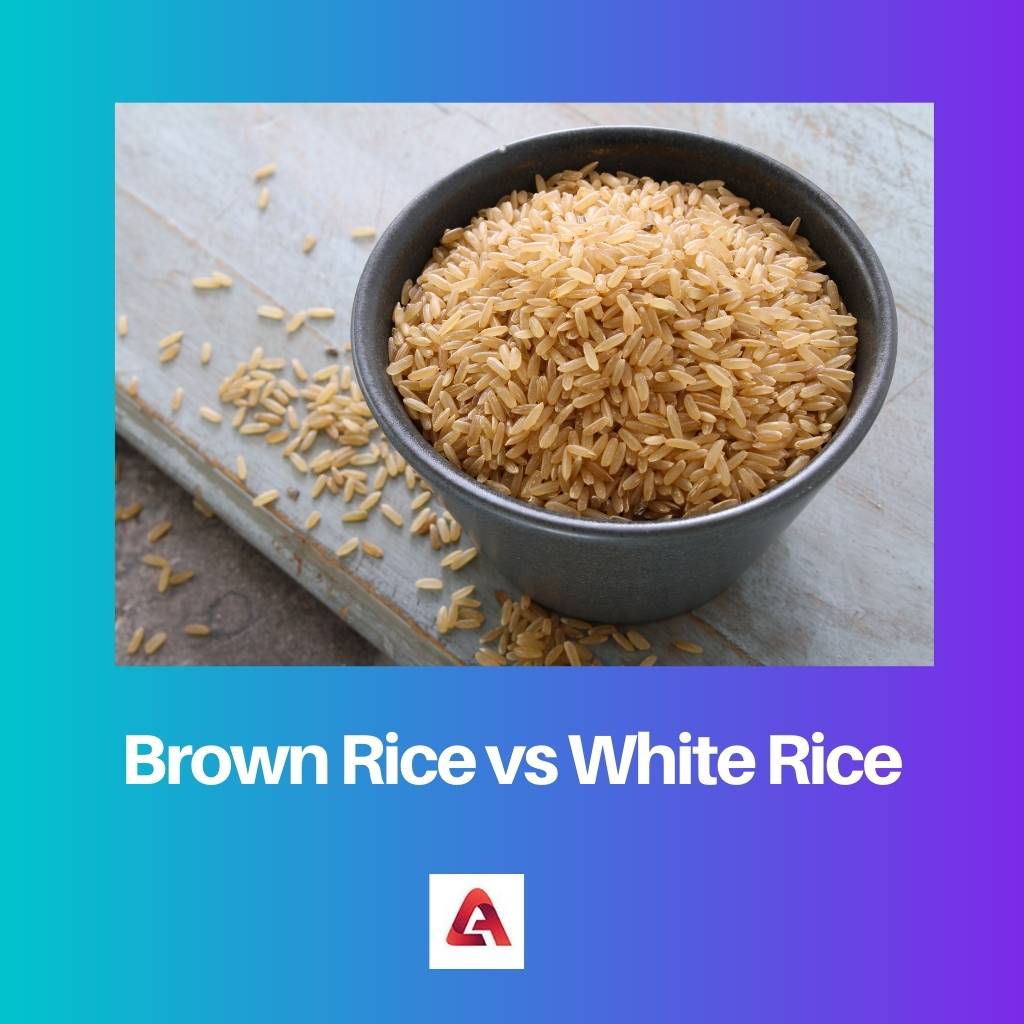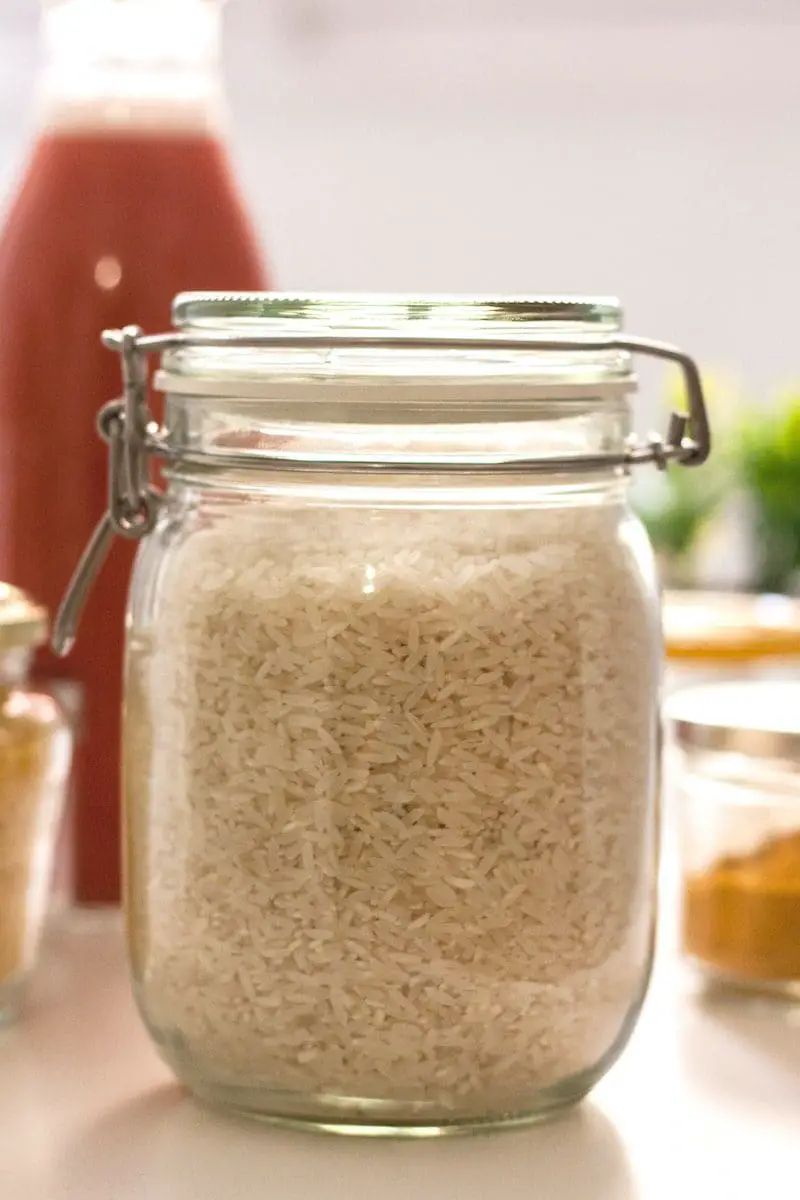Rice is the name of the seed of the grass species Oryza. Usually, the most popular species of domesticated rice that are consumed are Oryza sativa and Oryza glaberrima.
Brown and white rice belong to the same plant; however, they differ in their outer layers of the seed, nutritional value, and the most obvious characteristic is their color.
Key Takeaways
- Brown rice retains the bran layer and germ. White rice has these removed.
- The nutrient content is higher in brown rice due to intact layers.
- White rice has a longer shelf life and quicker cooking time.
Brown Rice vs White Rice
Brown rice is a whole grain seed and a variety of the standard rice species called Oryza. The rice is brown because the outer layer of the seed is left intact during processing. White rice is a variety of rice in which the chaff and outer layer are removed, and sometimes the grain is polished during processing.

Brown rice is a variety of whole rice grain whose outer hull or chaff has been removed, but the bran and cereal germ layer remains, giving it its characteristic brown color. Owing to its nutritious germ and bran layer, it is also rich in nutrients and fibers and is very healthy for consumption.
White rice is also a variety of whole rice grain whose outer hull or chaff has been removed but is also further processed to remove the bran and cereal germ layer that leaves only the endosperm filled with carbohydrates to be consumed.
Some varieties of white rice are also polished to remove any bran residues, which gives it a shiny exterior.
Its nutritive content is lower than brown rice.
Comparison Table
| Parameters of Comparison | Brown Rice | White Rice |
|---|---|---|
| Colour | As the name suggests it is brown in colour | It is clear white to glossy in colour. |
| Protective Seed Layers | Outer hull absent. Cereal grem layer present. Bran layer present. | Outer hull absent. Cereal germ layer absent. Bran layer absent. |
| Carbohydrate Content | 52 grams( In 1 cup of rice) | 45 grams ( In 1 cup of rice) |
| Calorie Content | 248 grams (In 1 cup of rice) | 205 grams (In 1 cup of rice) |
| Protein Content | 5.5 grams (In 1 cup of rice) | 4.3 grams (In 1 cup of rice) |
| Fat Content | 2 grams (In 1 cup of rice) | 0.4 grams (In 1 cup of rice) |
| Fibre Content | 3.2 grams (In 1 cup of rice) | 0.6 grams (In 1 cup of rice) |
| Other Nutrient Content | Brown rice is also known to contain thiamine, niacin, vitamin B6, manganese, magnesium, phosphorus, iron, zinc and sodium is considerable amounts. | Apart from sodium white rice contains almost negligible amounts of the stated nutrients. |
| Arsenic Content | Brown rice is can also be high in arsenic amounts as the outer layer of the seeds are not removed. Arsenic is a toxic chemical. | Environmental arsenic is removed from white rice during the outer layer removal making it less loaded with arsenic. |
| Antioxidants | Studies show brown rice to be high in antioxidants | White rice is shown to be low in antioxidants. |
| Anti-nutrients | Brown rice is shown to have higher levels of compounds like phytic acid that acts as an anti-nutrient and hinders nutrient absorption. | White rice has lower physic acid content. |
| Benefit of Consumption | Due to high nutritional value it is more healthy for consumption. | Since white rice only brings carbs and fats to the table is it less healthy for consumption. |
| Boiling Time | It takes slightly longer to boil | It is boiled or cooked faster |
| Texture | It has a rough texture while eating. | It is smoother in texture. |
What is Brown Rice?
Brown rice is a variety of the regular rice species Oryza. This whole grain seed is consumed by people looking for low carbohydrate and high fiber content in their staple diet.
During the processing of this rice, the outer layers of the seeds are left intact. The nutritive germ layer and bran layer of the seed are also consumed.
These added layers give the grain a brown color.
Brown is extremely beneficial for consumption due to the additional nutrients present in it. It is rich in manganese, magnesium, selenium, iron, zinc, phosphorus, sodium vitamins, niacin, thiamine, and so on.
Its rich fiber content also makes its digestion simpler. Consumption of brown rice makes one feel fuller faster.
This amount of consumption remains lower.
People looking for weight loss or suffering from diabetes are suggested to eat brown rice. However, brown rice is also known to contain higher levels of toxic chemicals like arsenic and phytic acid that is harmful for consumption.
| # | Preview | Product | |
|---|---|---|---|
| 1 |

| Nishiki Premium Brown Rice, 15-Pounds Bag | Check Price on Amazon |
| 2 |

| BEN'S ORIGINAL Whole Grain Brown Rice, 5 lb Bag | Check Price on Amazon |

What is White Rice?
White rice is a variety of the regular rice species Oryza. It is the whole grain seed of this plant whose outer chaff, germ layer, and bran layer have been removed during processing.
Some processing units even polish the seed to give it a shinier exterior.
White rice provides carbohydrates and calories to the consumer, while its nutritive value is low as the nutritive layers of the seed that provides nourishment to the seed during growth have been removed. It is also low in fiber content.
It is easier to digest as well as takes lesser time to cook. White rice is a variety of food and can be consumed in a number is ways.
Its high caloric value makes it the perfect food to gain energy from.

Main Differences Between Brown Rice and White Rice
- Brown Rice is an encapsulated grain with its nutritive seed layers, while white rice is consumed naked.
- Brown Rice is high in nutritive value, while white rice is not as rich in nutrients as brown rice.
- Brown rice has larger amounts of fiber per serving as compared to white rice.
- Brown rice takes longer to cook than white rice.
- Brown rice takes more time to digest than white rice. Hence the consumer might feel fuller for longer periods after eating brown rice.
- Brown rice can be consumed daily by people with diabetes. White rice could be avoided.
- Brown rice has a rougher texture in the mouth than white rice, which is smoother due to its polishing.
- Brown rice is also rich in antioxidants, while white rice is not.

- https://link.springer.com/article/10.1007/s13197-011-0232-4
- https://onlinelibrary.wiley.com/doi/abs/10.1111/1541-4337.12449



It’s important to consider the nutritional content and implications of brown and white rice. This article is a great resource for understanding the differences.
Absolutely, the detailed comparison table is particularly enlightening. It offers clarity on the nutritional disparities between brown and white rice.
The nutritional breakdown of both rice varieties is indeed essential for making informed dietary decisions. This article provides a thorough perspective.
The health benefits of brown rice are quite evident from the detailed dietary comparison. It’s crucial to be mindful of the nutritional value of the food we consume.
The article provides comprehensive information about the nutritional aspects of rice varieties. It’s crucial for making conscious choices about our diet.
Absolutely, understanding the benefits of brown rice can lead to more informed dietary choices. This breakdown provides valuable insights.
Rice is a staple food for many cultures around the world. Brown rice is certainly a healthier option due to its higher nutrient content. It’s important to be aware of the different aspects of rice consumption.
The breakdown of nutritional content and other factors is very informative. It helps in making informed choices about including rice in our diet.
I completely agree with you. The detailed comparison given here is quite helpful in understanding the differences between brown and white rice.
The comparison of brown and white rice is quite informative. It’s essential to be aware of the nutritional variations and their impact on our health.
I completely agree. This comparison table offers a clear understanding of the nutritional differences between the two rice varieties.
Understanding the nuances of rice consumption is essential for maintaining a balanced diet. This article provides valuable insights into the nutritional aspects.
It’s fascinating to learn about the detailed nutritional differences between brown and white rice. This is particularly helpful for those who are health-conscious.
Indeed, understanding the specifics of brown and white rice helps in making dietary decisions. It’s great to have access to such comprehensive information.
The details about brown rice and its health benefits are quite enlightening. This article provides a well-rounded view of rice consumption and its implications on health.
Absolutely, the comparison table is particularly helpful in highlighting the differences. It’s essential to be aware of the nutritional aspects of the food we consume.
The detailed information about the nutrition and health benefits of brown rice is quite valuable. It’s important to be mindful of our dietary choices.
The comparison of brown and white rice offers a comprehensive understanding of the nutritional disparities. This article provides valuable insights for making informed dietary decisions.
Indeed, understanding the specifics of brown and white rice is important for making well-informed dietary choices. This article offers a clear breakdown of nutritional variations.
The texture and nutrient breakdown of brown rice is intriguing. It’s essential to consider these factors when making dietary choices.
The details about brown rice and its health benefits are quite enlightening. This article provides a well-rounded view of rice consumption and its implications on health.
Absolutely, the comparison table is particularly helpful in highlighting the differences. It’s essential to be aware of the nutritional aspects of the food we consume.
The comparison between brown and white rice is an eye-opener. It’s interesting how the processing of rice can lead to significant nutritional variations.